SEJRANG
A Chess Variant By Simon Edward JeppsDownload ~ PDF ↷ ⋱
Introduction
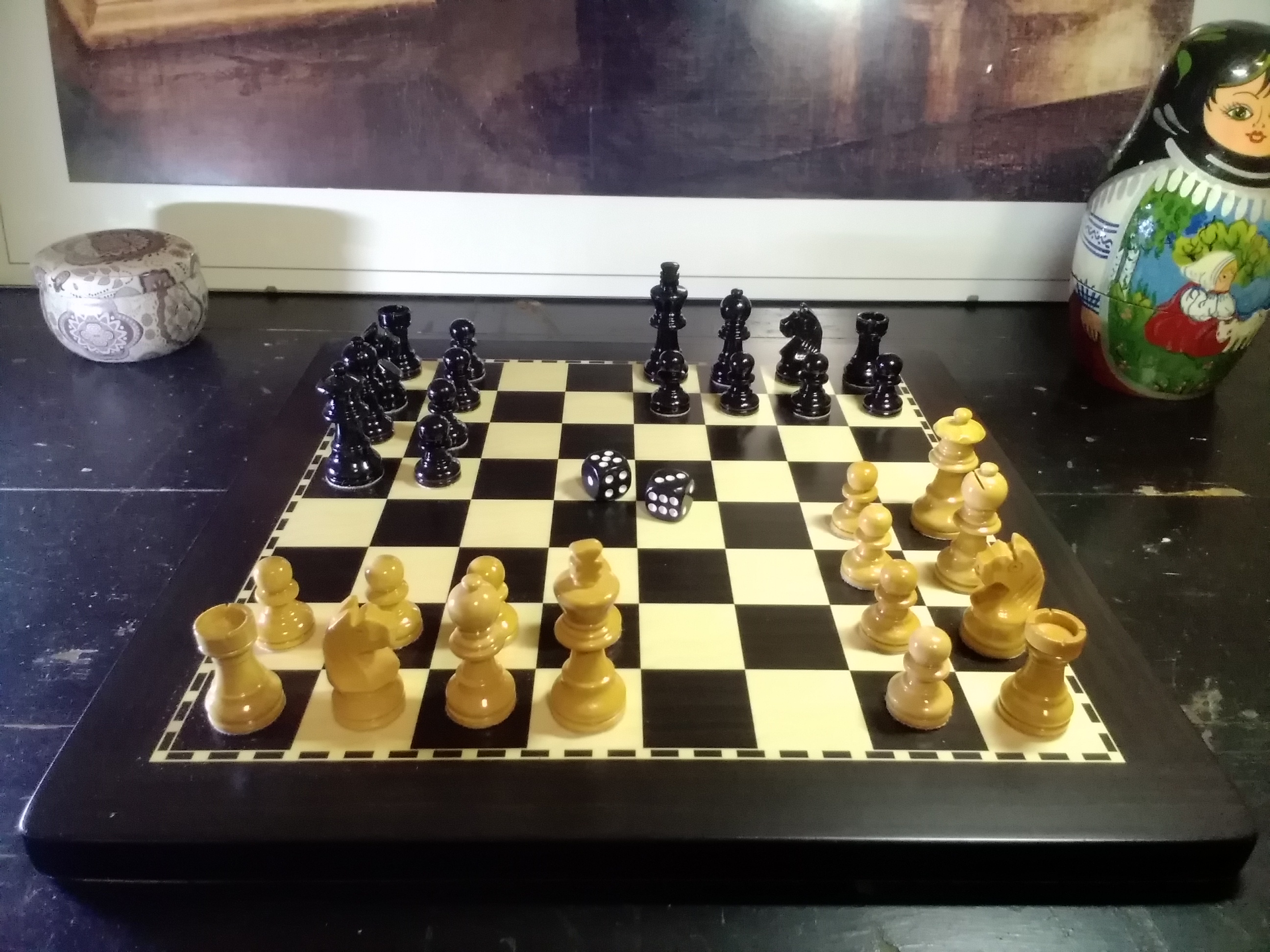 Sejrang is played with a regular Chess set but in a 'Chaturanga' style and features different or sometimes additional piece powers.
Sejrang is played with a regular Chess set but in a 'Chaturanga' style and features different or sometimes additional piece powers.
This game has been painstakingly designed with many years of Chess Variant expertise, to finally establish a unique yet complimentary Western transposition of Indian Chaturanga which not only works and which is not only entertaining, but which harbours truly well thought out logical constructs and mechanisms of play, proclaiming in the end result to have become perhaps one of the greatest rivals to the modern Western Chess world.
Anyone first setting out to design Chess Variants will soon discover that each and every new design presents itself to be yet another puzzle within yet another puzzle of as yet neverending puzzles, since by merely changing one aspect of the game you in turn create a cascading domino effect upon the atomical mechanics of the game as a whole.
In short, it is so very difficult to create a successful Chess Variant and this is why to this day, Classical Western Chess has remained the most popular modern form of the original, once a greatest Indian game.
Thus if you are one who has ever studied Chess Variants, someone I call a "Chessician", you will agree that reverse engineering the game to become once again like Chaturanga, with competitively entertaining logic and aesthetic appeal, is actually a monumental task which commands unprecedented, almost paradoxical problems to be solved.
So herewith, whence learning Sejrang, whilst you will find at face value some unexpected, unusual or "peculiar" changes to the way pieces move or interact, I am qualified to assure you, all these characteristics of the game are deliberately formulated to guarantee absolute logical compatibility with the Chaturanga style of gameplay and furthermore to deliver unto the player an especially new and absolutely "Biblical" euphoria of alternative Chess entertainment.
For example, one of the first things you will notice is how originally long range pieces like the Bishop, Rook and Queen are now medium range pieces. Yet the reason for this is not merely to "change the rules", for each piece has been re-designed to behave in a way which is logically compatible with the Chaturanga starting position and respective continuum of inter-board communication.
Of course then, these new changes have to not only be attractive to one familiar with Classical Chess but must also offer something "special" and "out of the box" in terms of competitional Chess intrigue. Indeed then, this is just one reason why for each and every piece which has been altered or apparently "diminished", these pieces are given an additional trait or novel characteristic which replenishes and even adorns their original majestic balance.
Yet the game of Sejrang truly goes much, much deeper than this, revealing deep within at the core of its heart, an absolutely enchanting soul and, if I may be so bold... The most fantastical Chess adventure ever gifted unto the world.
I hope you enjoy.
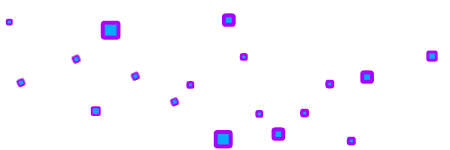
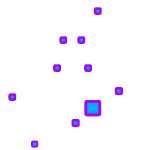

How To Play
INITIATION
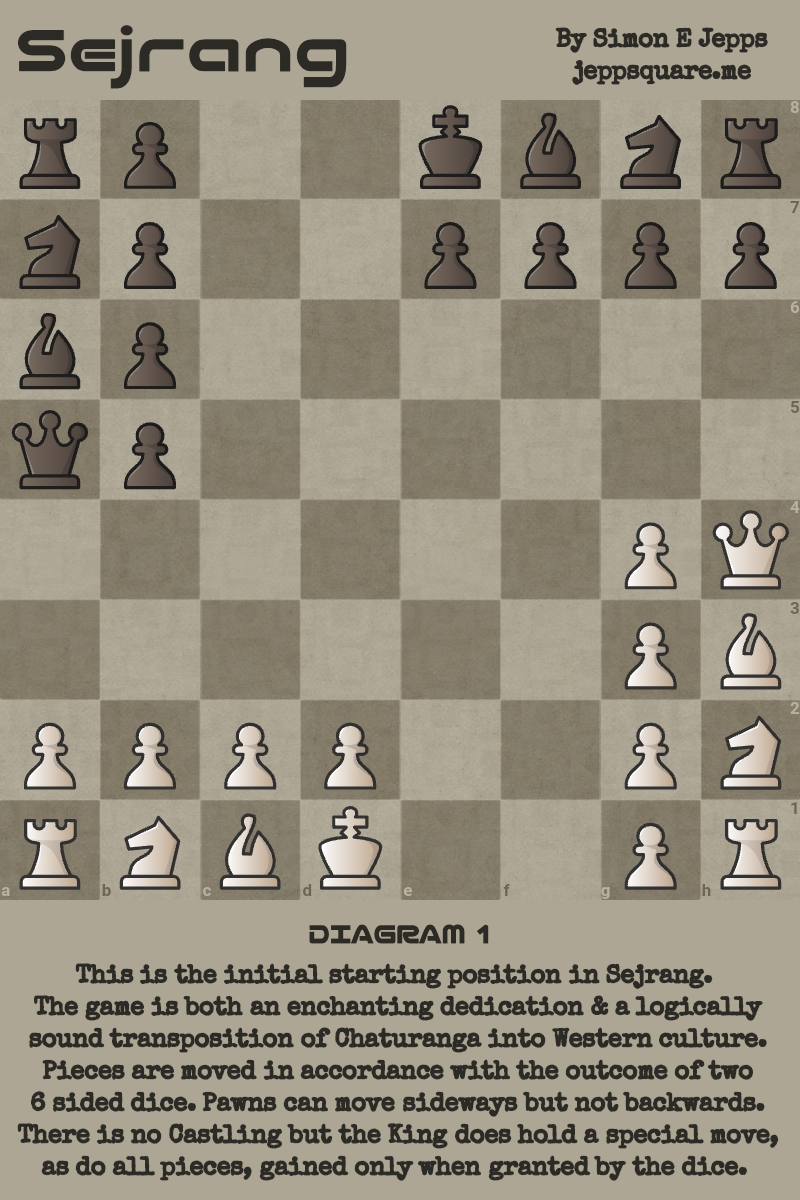 The objective of the game is to capture the opponent's King. There is no 'check' or 'check mate', but players utilize various natural elements of the game in order to corner their opponent and eventually capture the King.
The objective of the game is to capture the opponent's King. There is no 'check' or 'check mate', but players utilize various natural elements of the game in order to corner their opponent and eventually capture the King.
Sejrang employs a standard 64 square Classical Chess board & pieces.
Pieces may only be moved if instructed by the rolling of two 6-sided dice.
Various dice combinations grant different or additional options.
As in Chaturanga, the pieces are positioned along all four sides of the board, however in Sejrang, just two armies maintain the same inventory, with a Western alteration to the Indian placement and a complimentary change to piece powers.
This new initial board setup, with new rules and complimentary piece powers ensure the game of Sejrang to be both logically sound and socially enthralling.
The Kings are positioned at d1 (White) and e8 (Black) respectively, whilst the Queens are positioned at h4 (White) and a5 (Black) respectively.
From each corner towards the King or Queen, the pieces placed in order are Rook (in the corner), Knight and Bishop, whereby the King or Queen sits adjacent to the Bishop on the open end. The four Pawns per each division are then positioned in front of each the pieces as would be relative in Classical Chess.
THE DICE
Players take turns to roll both dice, whereby the outcome of the dice determines what pieces may be moved and with what special ability, if any.Only ONE piece may be moved in any turn.
The player must choose which one piece of whichever two piece values are shown on the dice to move in the turn. A player may RE-ROLL ONE DIE, but only one die one time, unless a DOUBLE is granted.
A player MUST move if possible to do so, or forfeit their turn.
The dice values and what these values represent are as follows...
- = Pawn
- = Knight
- = Bishop
- = Rook
- = King
- = Queen
- Double value = Both dice may be RE-ROLLED one time.
- Double 1 = Pawn may move TWO SQUARES orthogonally SANS capturing.
- Double 2 = Knight may move TWICE but SANS capturing.
- Double 2 x2 = Knight may move THRICE and CAPTURE (Dragon Fire).
- Double 3 = Bishop may JUMP the nearest diagonal square.
- Double 4 = Rook may TELEPORT to relative square of another quadrant, SANS capturing.
- Double 5 = King may move/capture like a KNIGHT.
- Double 6 = Queen may move/capture SIX SQUARES.
PAWN
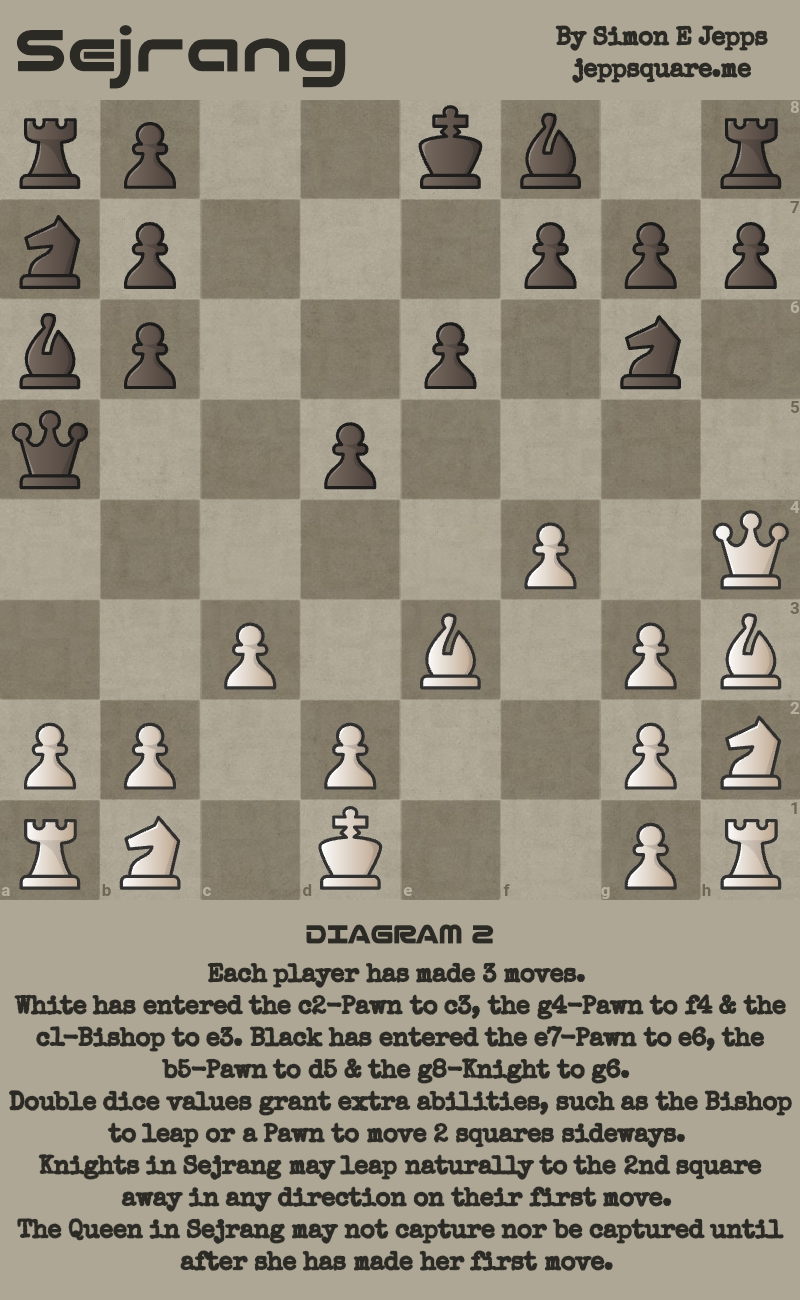 The Pawn of Sejrang MOVES without capturing similarly to a Classical Chess Pawn, thus ONE square vertically forward towards the Opponent's side of the board, but may ALSO move ONE square horizontally sideways.
The Pawn of Sejrang MOVES without capturing similarly to a Classical Chess Pawn, thus ONE square vertically forward towards the Opponent's side of the board, but may ALSO move ONE square horizontally sideways.
The Opponent's 'side of the board' is the 8th/1st rank.
The Pawn, as like Classical Chess, MAY ONLY CAPTURE by moving ONE square DIAGONALLY FORWARD towards the Opponent's side of the board.
Thus if Black, from b5xc4 or to a4, but not from b5xc6, for to c6 is backwards.
The Pawn MAY NEVER move BACKWARDS in any direction at any time.
A DOUBLE Pawn (1+1) dice roll grants the Pawn the option to move TWO SQUARES orthogonally forwards/sideways SANS capturing.
There is no En Passant in Sejrang.
KNIGHT
The Knight MOVES and captures like a Classical Chess Knight, in a 2-1 "L" shape, but may MOVE TWICE (x2) if without capturing whence a DOUBLE TWO is rolled.Dragon Fire
If a DOUBLE TWO is RE-ROLLED and a DOUBLE TWO is granted AGAIN, then the Knight may MOVE THRICE (x3) and CAPTURE, yet capturing only to the final destination square. This is called 'Dragon Fire' in Sejrang and is extremely difficult to gain. 'Dragon Fire' MAY NOT be used to capture the King.
The Knight may jump and/or capture to ANY 2nd SQUARE AWAY on its FIRST MOVE.
Only ONE Knight may be moved in any turn.
BISHOP
The Bishop MOVES and captures THREE SQUARES diagonally but may JUMP the nearest diagonal square whence a DOUBLE THREE is rolled.ROOK
The Rook MOVES and captures FOUR SQUARES orthogonally but may TELEPORT to the relative square of another quadrant, SANS capturing, whence a DOUBLE FOUR is rolled.Teleportation
The board is divided into FOUR QUADRANTS each defined naturally by the initial starting positions of each the four armies, SIXTEEN squares per quadrant.
When a Rook TELEPORTS it moves WITHOUT CAPTURING to the relatively identical square of another quadrant. For example a1 is the same as a5, e1 and e5; ~ the lower left corner square of the 4x4 grid from White's perspective, or the upper right corner square from Black's perspective.
The destination square MUST BE VACANT and the Rook MAY NOT make any other move, only to move ONCE between those TWO SQUARES.
QUEEN
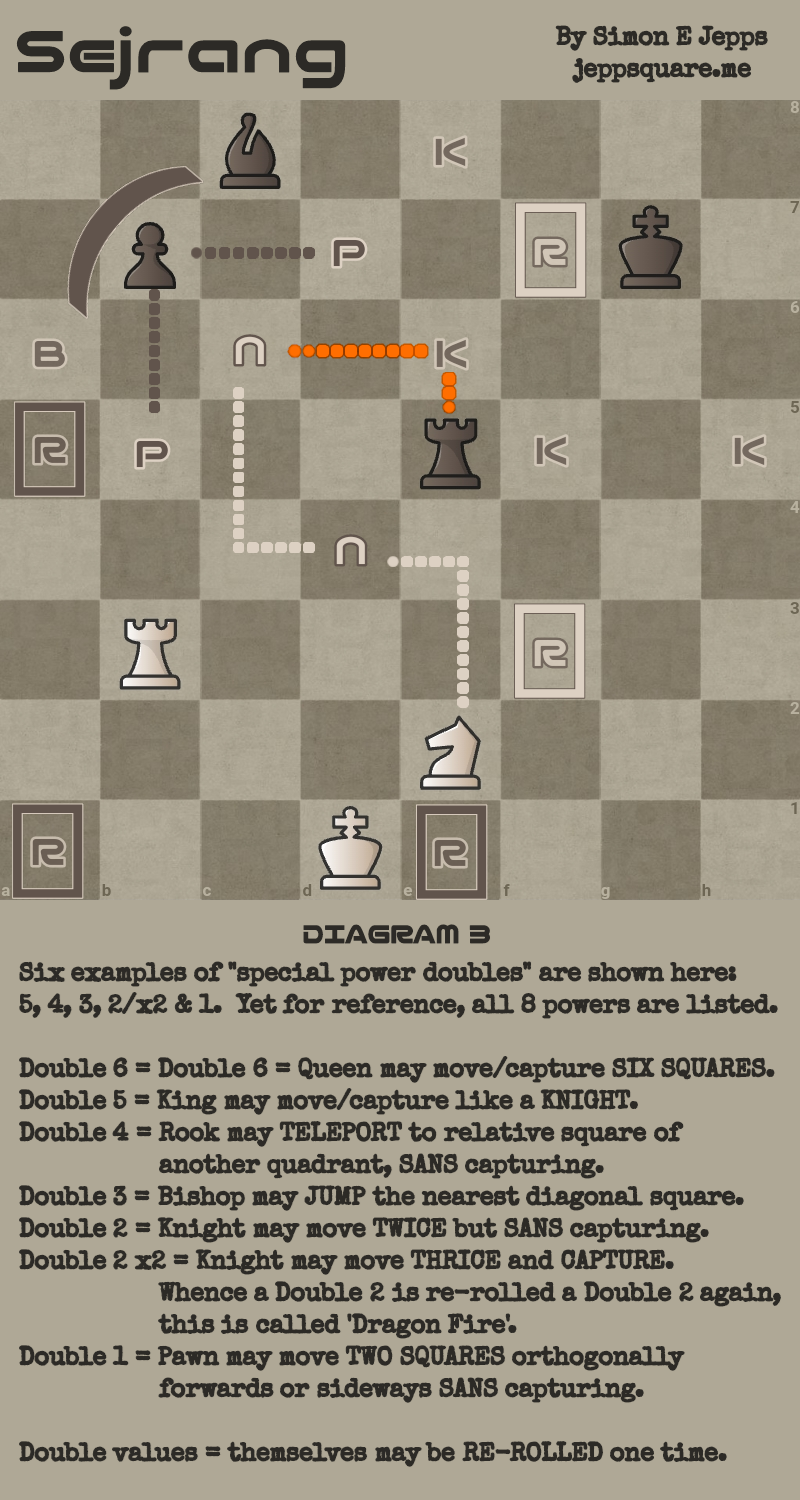 The Queen MOVES and captures TWO SQUARES in ANY DIRECTION but may move and capture SIX SQUARES whence a DOUBLE SIX is rolled.
The Queen MOVES and captures TWO SQUARES in ANY DIRECTION but may move and capture SIX SQUARES whence a DOUBLE SIX is rolled.
The Queen MAY NOT CAPTURE NOR BE CAPTURED until AFTER she has made her FIRST MOVE.
Queen Half Point
The Queen awards an EXTRA HALF POINT to the winner/loser. So for example, if White captures the Queen before also capturing the King, White receives ONE + HALF points and the game is scored 1½ - 0.
However, if Black had ALSO captured the Queen and yet lost, the game would thence have been scored 1½ - ½.
There are very rarely draws in Sejrang. However, a draw of equal material gain is nevertheless scored as merely ½ - ½.
Resignation counts as a King sacrifice and thus the game is scored as if the King had been successfully captured instead.
KING
The King MOVES and captures ONE SQUARE in ANY DIRECTION but may move and capture like a KNIGHT whence a DOUBLE FIVE is rolled.The original game of Indian Chaturanga features a rule which allows the King to move like a Knight for one time in the game. This was a defensive trait given to the King which Western Chess replaced with 'Castling' once the game had adopted different mechanics. Since Sejrang is a blending of both Western & Indian mechanics, whereby unfair attacks on the King may prove more regular (as a result of increased combat between two big direct combatants, as opposed to four small indirect combatants), I deemed it neccessary to make this move more common place with a "double five" dice roll.
The King CAN be CAPTURED at ANY time, however 'Dragon Fire' MAY NOT be used to capture the King.
There is NO CASTLING in Sejrang.
PROMOTION
A Pawn may only promote onto one of the FOUR CENTRAL King-side squares of the farthest rank; thus onto c8, d8, e8 or f8 if playing White, or onto c1, d1, e1 or f1 if playing Black. Yet remember Pawns may also move sideways or capture diagonally, and sometimes two squares sideways depending on the dice.A Pawn may only promote to and thus reinstate, a piece previously captured.
Promotion is notated by placing the new piece's initial in brackets after the Pawn's move, such as if playing Black, h1f1(N).



Summary
People argue that Chess with dice is merely a game of chance and that it lacks the individual creative intellect which makes Classical Chess the professional international sport we know today.Aye, there is a difference for sure, but in terms of "individual creative intellect" the game of Sejrang actually harbours a likewise academically professional relationship with those who play it. Not least to say those of the mathematical schools.
It is actually safe to say that a child prodigy of Chess would be sooner to emerge than a child prodigy of Sejrang and this is because, unlike Chess, the game of Sejrang requires more than the mere knowledge of pattern recognition, memory augmentation and problem solving, it ALSO requires a good understanding of mathematics, probability, constant sacrifice and commanded discipline.
Yet and even without taking into account any of these, we have nevertheless presented before us an academically enticing intellectual challenge.
This is because even if you are already very good at Chess, thence when you find yourself in a Sejrang position where you have lost almost all your pieces against a mere novice from the Classical Chess scene, THIS will be the moment of your career to prove your mastery at the board as you attempt, against all odds, to resurrect your King's prowess and overthrow the dark forces of chance and misfortune.
Do you see the wizard amongst the trees now?
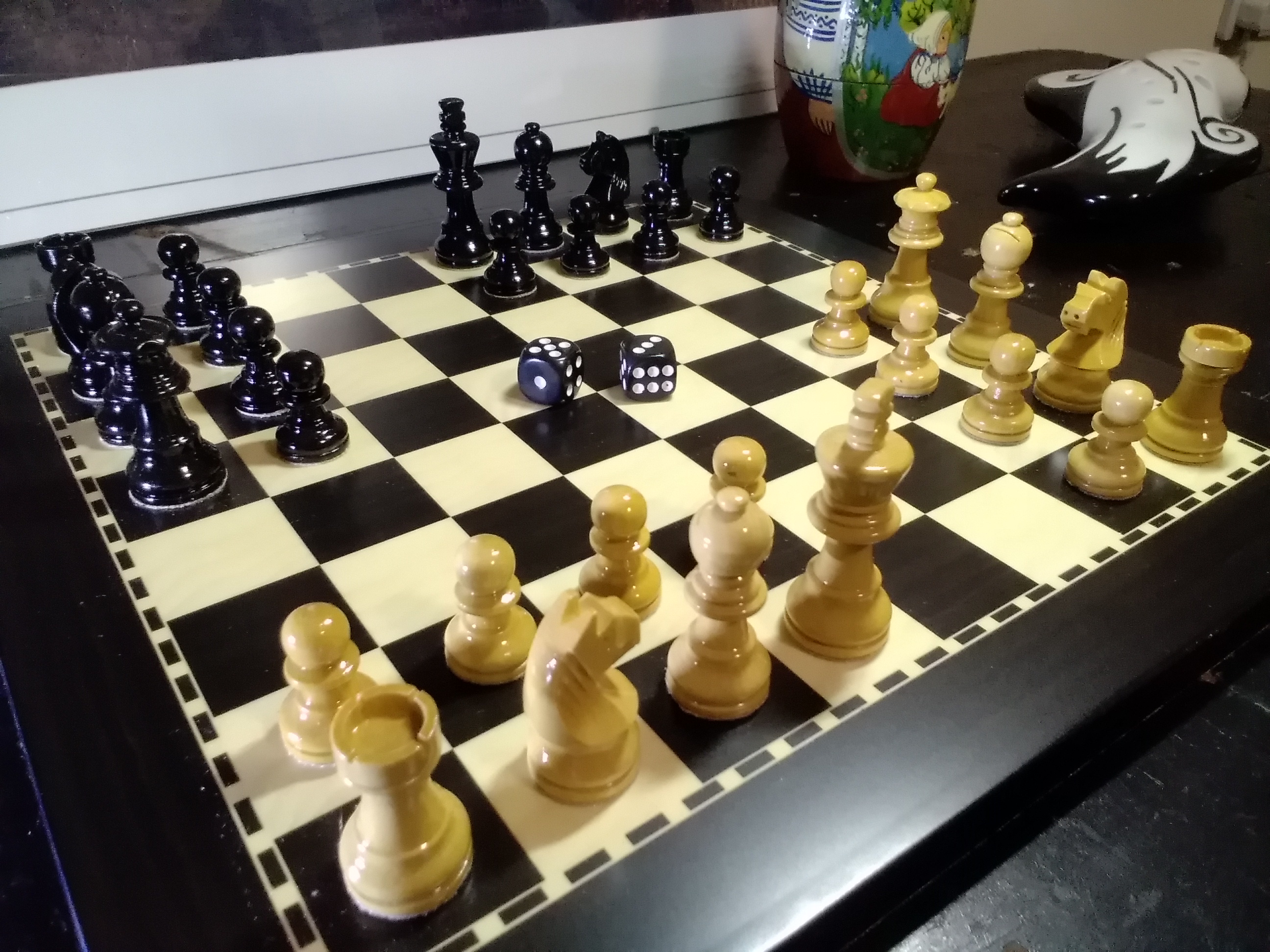 Without question, the ONE aspect of Classical Chess which destroys its seeming timeless appeal is the eventuality of how ONE miscalculated move WILL in most professional games completely DESTROY your hard-earned advantage.
Without question, the ONE aspect of Classical Chess which destroys its seeming timeless appeal is the eventuality of how ONE miscalculated move WILL in most professional games completely DESTROY your hard-earned advantage.
Whilst lending this advantage unto a pair of dice sounds like a suicidal contradiction in terms, it is far from suicide.
Suicide is watching yourself making the worst possible mistake with the knowledge that, if only sans the distractions of your painful life, you know you could have done better.
Sejrang is the gift of being given another chance to watch your opponent turn to slime as your last remaining Knight is given the power to jump thrice with a thundering discovered attack of the Dragon's Fire.
Here then we have truth translated. The first game is a lifetime of slaving away at a Chess board, studying centuries of literature and sacrificing hours after hours of sleep, in the hope that you won't, at your next tournament, make that atomically tiny yet fatally fragile mistake again.
The second game... Sejrang... is actually fun.
Thank you for reading.
 |  |



